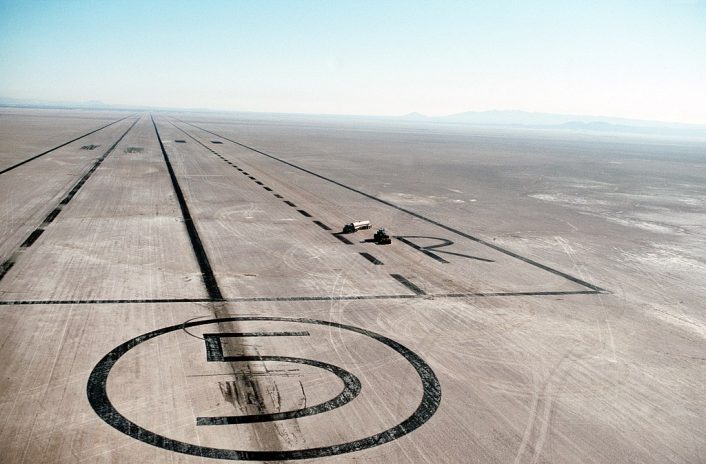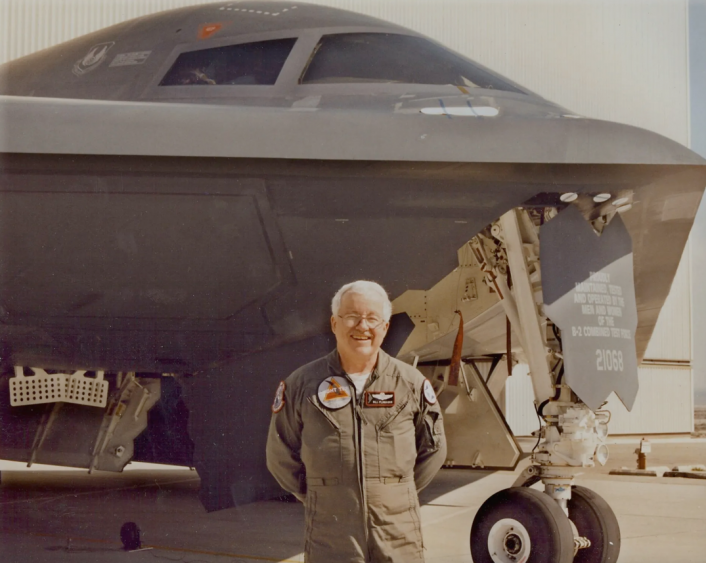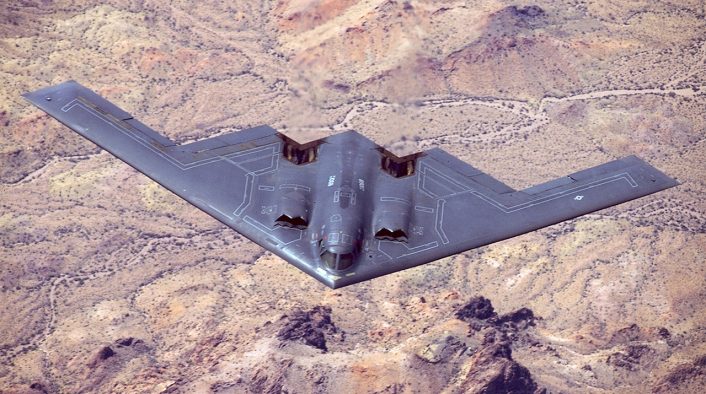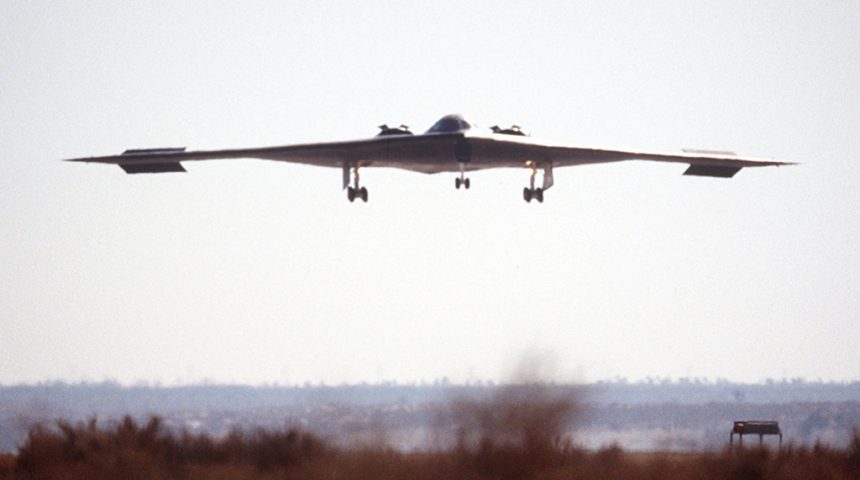This is the story of the B-2A Spirit AV-3 (Air Vehicle 3) and its emergency landing during a test flight.
Today, we have become quite used to the shape of the B-2A Spirit, but more than 30 years ago, when the Northrop Grumman’s flying-wing made its first public appearance and flight, the the tailless fixed-wing aircraft with no definite fuselage, with its crew, payload, fuel, and equipment housed inside the main wing structure, seemed to be almost out of this world: the stealth bomber was the first flying wing to fly over the Mojave Desert in nearly 4 decades.
While someone may argue that the Spirit stealth airplane STILL looks like an alien spacecraft, back then, the fact the B-2 was completely different than any other airplane at Edwards Air Force Base, California, had an impact also on the emergency response procedures in place at Rogers Dry Lake, the central part of the base home to the Air Force Flight Test Center.
Rogers Dry Lake has been used for emergency and test landings of aircraft for more than 50 years. It was also the landing site for early Space Shuttle test and operational flights. There are seven “drawn on” runways crisscrossing the surface of Rogers, with the longest extending 7 1/2 miles.

“These natural flat surfaces have literally saved hundreds of aircrew lives and aircraft valued at millions of dollars because the lakebeds offer a broad expanse of hardened clay on which to land in emergency situations,” says the NASA Armstrong Flight Research Center (a civilian tenant organization within the boundaries of Edwards Air Force Base) on the northwest edge of Rogers Dry Lake, in its official website.
Before the B-2 started operating out of Edwards AFB, when an aircraft made an emergency landing on the dry lakebed, “firetrucks from the base would simply drive around searching for some trace of a tail sticking up” (or smoke…in case of crash landing). But the Spirit didn’t have any tail. Therefore, finding the Air Vehicle 3 (82-0168) after it performed a successful emergency landing on Rogers Dry Lake proved to be quite difficult.
The following article recalls the whole story of that flight. Written by William “Flaps” Flanagan, Lt. Col., USAF (Ret.) – Flight Test Weapon System Operator (NGC), it was originally posted on the website of Flight Test Museum Foundation. We were give the permission to repost it here at The Aviationist by Rebecca Reeder, General Manager of the Flight Test Museum Foundation.
The story is great as it also explains how that mishap led to a change in the way firetrucks responding to emergency landings on the lakebed operated (needless to say, smaller aircraft with a tail would be as difficult to find as the tailless B-2…).
“What do you mean, you couldn’t FIND the B-2 on the lakebed?”
by William “Flaps” Flanagan, Lt. Col., USAF (Ret.) – Flight Test Weapon System Operator (NGC)

Air Vehicle 3 (82-0168) – later named Spirit of New York – was the first fully functional B-2 bomber with bomb bays, weapons computers, navigation systems, radars, etc. and was built 2 years after the Air Vehicle-1 first flight. AV-1 and AV-2 had F-16 INS and no real way to release weapons other than jettison and assume gravity would ensure the weapon impacted within the proper hemisphere of the earth.
As a navigator/weapon systems officer (WSO) with experience in bombing and nav systems as well as flying B-2 C-135 testbed AFTB on six-hour missions, I was anxious to see what a real B-2 could do. AV-3 would be the first opportunity to see it for real.
AV-3 had a new car smell but a used new car due to being parked outside while we checked out the new avionics “toys”. My first B-2 flight was AV-3’s third flight and it went great. However, my third flight was not so great. I was flying with Cal Jewet with whom I flew the SR-71 for 2 years, so we knew each other well. Our F-16 chase reported after takeoff that one of the B-2 landing gear doors was not completely closed. We put the gear handle down to recycle and uh oh, now the gear would not extend at all on the right side.
This was serious.
We went through the checklist—several circuit breakers to check to ensure they had not popped. No luck. We set up a conference call coast to coast, but it took an hour to organize. Fortunately, we had lots of gas.
Aside: The 1950’s vintage C-135 AFTB could hand crank gear down, but it took 15-20 minutes. B-2 was computerized with no hand cranks, but there was also an emergency switch that bypassed the computers and simply unlocked the door and gear uplocks and let gravity take over.
After the conference call had convened the suggestion was to check the circuit breakers. Already done, but to keep everyone happy we did it again. Check circuit breakers: done. Next suggestion was to use the emergency gear switch. Emergency gear extend. As the guy reading the checklist, I actually threw the switch and I nervously realized a 2-billion-dollar warplane was riding on the new guy. The chase pilot reported the right gear door opening and the right landing gear slowly dropping into place. Success! Three green lights on the panel indicating all three struts were down and locked. Hurray! The B-2 program would not make the evening paper headlines!
Since Edwards was built next to the largest playa (dry lakebed except for occasional fillings during the wet season) on the globe and it only had one main concrete runway, it was customary to use Rogers Dry Lake as an emergency landing field if required and if it was dry. The longest lakebed runway was over 10 miles long so even if brakes failed, friction would eventually stop an airplane.
As we set up to land on the lakebed (I had only done it once in Test Pilot School in 1976), we received a call from our Mission Control Room requesting we return the emergency landing gear switch to the normal position. We both looked at each other without saying a word, but our eyebrows over our masks said it all. Cal said over the radio, “We’ve got three green lights on the gear, we’re about to land on the lakebed for the first time. We still don’t know what caused the problem; let’s just leave the switches where they are, shall we?”
Aside: On a six-mile-wide lakebed; we can’t see the base buildings from the center of the lakebed. It is like a fly landing in the middle of a soup bowl. Solution: Taxi to the west on compass heading until we can see buildings and get oriented, then steer toward the few “off- ramps” where we can go from the lakebed to the concrete taxiways.
B-2 stops successfully and since gear is still under suspicion, we wait for the fire department to appear and insert downlocks.
We wait. And wait and wait. No firetrucks.
We look like a scene from the movie Lawrence of Arabia — just this 172-foot-wide flying wing all by itself in a vast wasteland. Still waiting, the firetrucks are on a different radio frequency and don’t know where THEY are, much less the B-2. Meanwhile, the B-2 is heating up (it’s July). We discuss we may have to shut down in place to avoid overheating the avionics. Next question — since we seem to have been abandoned — Do we have wheel chocks to keep the plane from rolling away after we shut down? Nope. They cleared out everything from the flight deck so if we were doing flight test maneuvers and got too enthusiastic, we wouldn’t knock ourselves out with flying wheel chocks. Great.
The only portable thing we had was a 25 lb. nav bag in which we carried all our classified material. So, Plan C was to shut down and I would open the inner and outer hatches, extend the folding ladder, and climb out – carrying the nav bag. I would study the lay of the land and then throw the nav bag under the appropriate wheels if I detected motion (if no motion I would flip a mental coin where to put it).
And before you ask, we do have a parking brake on the B-2, but it was still under test on the new jet — and ever since the Wright Brothers switched from skids to wheels, it has been customary to put something under the wheels to keep the plane stationary. It’s embarrassing to have the pilot chasing the airplane, even if it costs less than hundreds of millions of dollars.
Fortunately, as we were preparing to shut down, the firetrucks finally arrived. They plugged in to our intercom system and apologized for the delay. The problem was the B-2 had no vertical tail (like every other airplane at Edwards) and the firetrucks were driving around searching for some trace of a tail sticking up; just as pilots taxiing from the lakebed looked for the skyline of buildings to orient themselves. (If we had crashed, the column of smoke would have been a giveaway but fortunately that was not a dead giveaway). The tower operator could see both the B-2 and the firetrucks and tried to talk them to the B-2, but that turned out to be somewhat like directing a Keystone Cops chase sequence from the director’s chair; more easily said than done.
All ended well. The nav bag was not crushed with all its secrets.
After our landing, there was a suggestion to outfit the firetrucks with GPS and the aircraft on the lakebed could relay its GPS position via the tower so the lack of a tail would no longer be a problem. Also, a location was found for wheel chocks on the B-2 flight deck that would not endanger the crew during what passed for violent maneuvering in a bomber.
Oh! and the reasoning behind the request to place the gear switch to normal was in Emergency extension of the B-2 landing gear, the nose gear door would remain open and the cloud of dust and dirt on the lakebed would get the nose bay “dirty”.
The reason the computerized gear extension did not work was because using a real B-2 with real avionics as an outdoor test laboratory we had to ‘fool” the airplane into thinking it was airborne when it was not. Due to that setup it was possible to confuse the computers as to the proper order in which to send hydraulic commands to the landing gear. The problem never recurred as the test force became more familiar with “a real B-2”.










